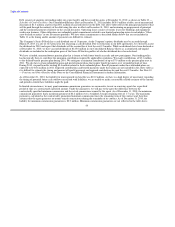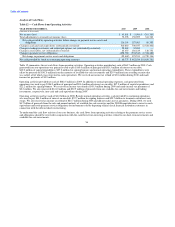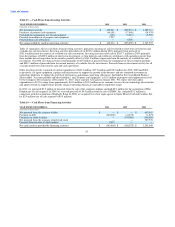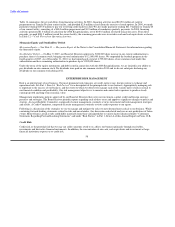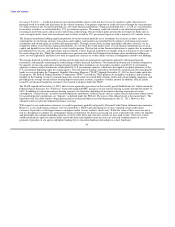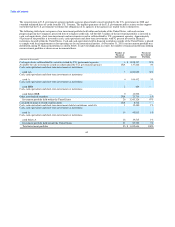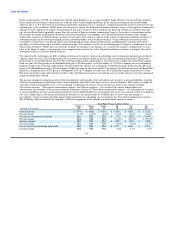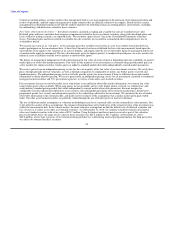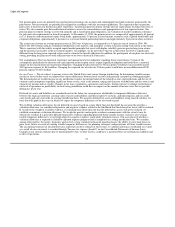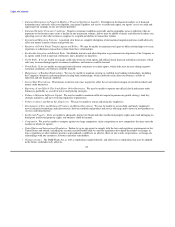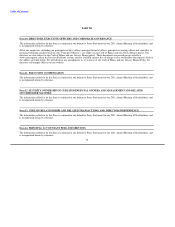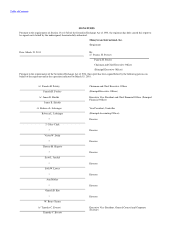MoneyGram 2010 Annual Report Download - page 68
Download and view the complete annual report
Please find page 68 of the 2010 MoneyGram annual report below. You can navigate through the pages in the report by either clicking on the pages listed below, or by using the keyword search tool below to find specific information within the annual report.
Table of Contents
Critical accounting policies are those policies that management believes are most important to the portrayal of our financial position and
results of operations, and that require management to make estimates that are difficult, subjective or complex. Based on these criteria,
management has identified and discussed with the Audit Committee the following critical accounting policies and estimates, including
the methodology and disclosures related to those estimates.
Fair Value of Investment Securities — Investment securities classified as trading and available-for-sale are recorded at fair value.
Realized gains and losses and other-than-temporary impairments related to these investment securities, along with unrealized gains and
losses related to trading securities, are reported in the "Net securities (gains) losses" line in the Consolidated Statements of Income
(Loss). Unrealized gains and losses related to available-for-sale securities are recorded in accumulated other comprehensive loss in
stockholders' deficit.
We measure fair value as an "exit price," or the exchange price that would be received for an asset in an orderly transaction between
market participants on the measurement date. A three-level hierarchy has been established for fair value measurements based upon the
observability of the inputs to the valuation of an asset or liability, and requires that the use of observable inputs be maximized and the use
of unobservable inputs be minimized. The fair value hierarchy gives the highest priority to unadjusted quoted prices in active markets for
identical assets or liabilities and the lowest priority to unobservable inputs.
The degree of management judgment involved in determining the fair value of an investment is dependent upon the availability of quoted
market prices or observable market parameters. Fair value for the majority of our investments is estimated using quoted market prices in
active markets for similar securities, broker quotes or industry-standard models that utilize independently sourced market parameters.
We receive prices from an independent pricing service for the vast majority of the fair value of our investment securities. We verify these
prices through periodic internal valuations, as well as through comparison to comparable securities, any broker quotes received and
liquidation prices. The independent pricing service will only provide a price for an investment if there is sufficient observable market
information to obtain objective pricing. We receive prices from an independent pricing service for all investments classified as residential
mortgage-backed securities and U.S. government agencies, as well as certain other asset-backed securities.
For investments that are not actively traded, or for which there is not sufficient observable market information, we estimate fair value
using broker quotes when available. When such quotes are not available, and to verify broker quotes received, we estimate fair value
using industry-standard pricing models that utilize independently sourced market observable parameters, discount margins for
comparable securities adjusted for differences in our security, risk and liquidity premiums observed in the market place, default rates,
prepayment speeds, loss severity and information specific to the underlying collateral to the investment. We maximize the use of market
observable information to the extent possible, and make our best estimate of the assumptions that a similar market participant would
make. Our other asset-backed securities are primarily valued through the use of broker quotes or internal valuations.
The use of different market assumptions or valuation methodologies may have a material effect on the estimated fair value amounts. Due
to the subjective nature of these assumptions, the estimates determined may not be indicative of the actual exit price if the investment was
sold at the measurement date. In the current market, the most subjective assumptions include the default rate of collateral securities and
loss severity as it relates to our other asset-backed securities. As of December 31, 2010, we continue to hold investments classified as
other asset-backed securities with a fair value of $23.7 million. Using the highest and lowest prices received as part of the valuation
process described above, the range of fair value for these securities was $23.2 million to $31.6 million. At December 31, 2010,
$20.8 million, or less than 1 percent, of our total investment portfolio was valued using internal pricing information. No third party price
was able to be obtained for these securities.
65


